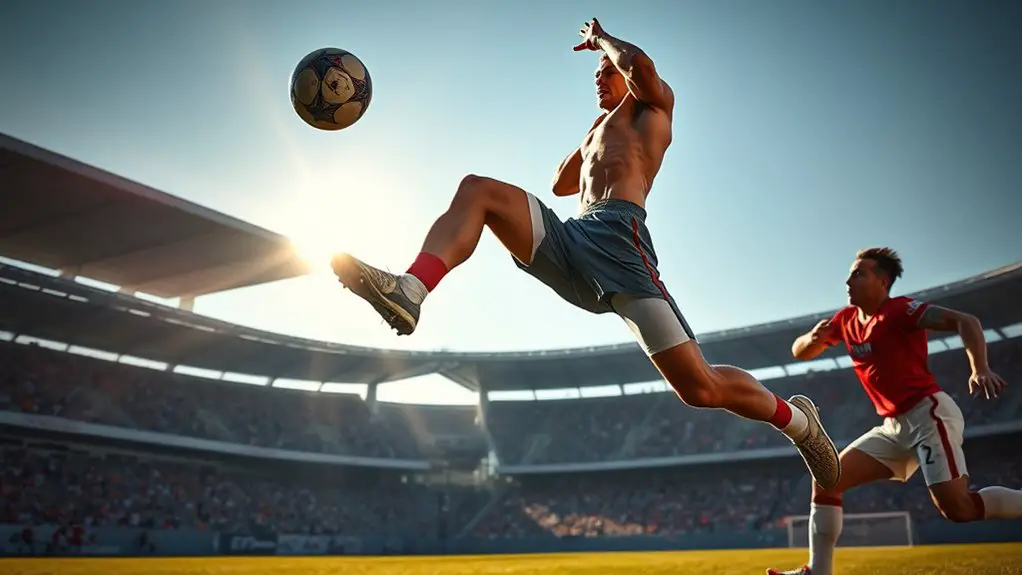The strength-to-weight ratio is essential in soccer as it influences your agility, speed, and performance on the field. A higher ratio can enhance your quickness, allowing you to move swiftly and maintain better balance while tackling opponents. Balancing strength and weight is key to maximizing power without excess mass. This balance not only improves explosive movements but also aids in injury prevention. Discover how you can optimize your training for even better results and performance enhancement.
Understanding Strength-To-Weight Ratio
When you think about athletic performance, the strength-to-weight ratio often plays an essential role, especially in soccer. This concept combines the strength definition—your ability to exert force—with the weight significance of your body. Fundamentally, it's about how much strength you can apply relative to how much you weigh. A higher strength-to-weight ratio means you can perform better, whether it's sprinting down the field or outmuscling an opponent for the ball.
For soccer players, this balance is critical. You want to be agile and quick, but also powerful. If you gain too much weight without increasing strength, your ratio drops, making it harder to maintain that explosive speed. Conversely, if you focus solely on losing weight, you might sacrifice strength. Finding that sweet spot empowers you to express your athleticism freely, enhancing your overall performance on the pitch. Incorporating functional strength training can help improve your strength-to-weight ratio and overall athletic performance. Embrace this balance to reach your peak potential!
The Role of Strength in Soccer Performance
Strength plays an essential role in your soccer performance, impacting both muscle power and endurance on the field. When you're stronger, you can sprint faster, tackle harder, and maintain your energy throughout the match. Plus, building strength can help you avoid injuries, keeping you in the game longer. Incorporating squats and deadlifts into your training routine can significantly enhance your overall strength and stability, further optimizing your performance on the field.
Muscle Power and Endurance
Although many factors contribute to success in soccer, muscle power and endurance play an essential role in enhancing performance on the field. You need explosive strength for powerful shots and quick direction changes, while endurance helps you maintain energy throughout the match. Engaging in endurance training can boost your stamina, allowing you to outlast opponents and execute plays effectively. Don't forget about muscle recovery, either; it's vital for keeping your body in top shape after intense workouts. Stretching, hydration, and proper nutrition aid recovery, ensuring you're always ready to give your best. By focusing on both muscle power and endurance, you'll not only improve your game but also enjoy the freedom to express yourself on the pitch.
Injury Prevention Strategies
Incorporating effective injury prevention strategies is essential for maintaining peak performance on the soccer field. To keep yourself in the game, focus on strength training that enhances your strength-to-weight ratio. Combine this with flexibility training to improve your range of motion and reduce the risk of injury. Don't underestimate the power of rehabilitation techniques; they can help you recover faster from any setbacks and get you back on the field stronger than before. Prioritize dynamic warm-ups and targeted exercises that strengthen vulnerable muscle groups. Remember, a proactive approach to injury prevention not only enhances your performance but also grants you the freedom to play without fear of getting sidelined. Stay fit, stay free, and enjoy your game!
How Weight Affects Agility and Speed
Your weight plays an essential role in how agile and fast you can be on the field. Lighter players often find it easier to execute quick movements, maintaining better balance and control during play. Understanding this relationship can help you optimize your performance in soccer.
Impact on Quick Movements
When it comes to quick movements on the soccer field, weight plays an essential role in determining agility and speed. If you want to enhance your game, balancing your strength-to-weight ratio is key. Lighter players often enjoy quicker footwork, allowing them to dart around defenders and change directions effortlessly. With less weight to carry, you can achieve explosive acceleration, making those critical sprints more effective. Imagine easily weaving through opponents and positioning yourself for those game-winning plays. It's not just about being fast; it's about being nimble. By optimizing your weight, you release your potential, boosting performance during intense moments when every second counts. Embrace the freedom that comes with a well-tuned body, and watch your game soar.
Balance and Control Factors
While many players focus solely on strength training, the intricate balance between weight and control is essential for maximizing agility and speed on the field. Your weight directly affects your ability to maneuver effectively. To enhance your performance, consider these balance techniques and control drills:
- Core Strengthening: Build a strong core to improve stability and control during quick movements.
- Dynamic Stretching: Incorporate dynamic warm-ups to enhance flexibility and reduce injury risk.
- Footwork Drills: Practice agility ladders and cone drills to sharpen your foot speed and coordination.
- Weighted Exercises: Use resistance training wisely; focus on maintaining a light weight while boosting strength.
Benefits of a High Strength-To-Weight Ratio
A high strength-to-weight ratio can greatly enhance your performance on the soccer field, allowing you to move quicker and maintain better agility. When you focus on strength training, you're not just building muscle; you're also optimizing your body's efficiency. This means you can sprint faster, change directions with ease, and outmaneuver opponents.
Effective weight management plays a key role here. By keeping your weight in check while increasing strength, you're maximizing your power without the drag of excess mass. This balance gives you the freedom to express your skills fully, whether it's making that vital tackle or scoring the game-winning goal. Incorporating compound movements into your training can further enhance your explosive power and overall performance.
Ultimately, a high strength-to-weight ratio empowers you to perform at your best, providing the advantage you need to excel in the game. Embrace this approach, and you'll notice the difference on the field.
Training Techniques to Improve Strength
To boost your strength for soccer, incorporating bodyweight exercises can work wonders. You'll also want to explore resistance training methods and integrate plyometric drills for explosive power. Each technique plays an essential role in enhancing your overall performance on the field. Additionally, focusing on functional strength through compound movements like squats and deadlifts can significantly improve your strength-to-weight ratio.
Bodyweight Exercises Benefits
Bodyweight exercises offer numerous benefits for improving strength, especially for athletes like soccer players who rely on their agility and endurance. You can enhance your performance through these bodyweight benefits while enjoying exercise efficiency. Here are four key advantages:
- Functional Strength: You build strength that translates directly to your performance on the field.
- Flexibility: These exercises improve your range of motion, essential for quick movements and turns.
- Core Stability: A strong core is critical for balance and control during play.
- Accessibility: You can do bodyweight exercises anywhere, anytime, without the need for equipment.
Incorporating these exercises into your routine can empower your game and boost your overall athleticism.
Resistance Training Methods
While bodyweight exercises are effective, incorporating resistance training methods can greatly enhance your strength and power on the soccer field. Resistance band exercises are a fantastic way to build muscle without the need for heavy weights, allowing you to improve your agility and flexibility. You can use bands for various movements, targeting essential muscle groups for soccer performance. On the other hand, weightlifting techniques like squats, deadlifts, and bench presses can help you develop raw strength. These exercises increase your explosiveness, vital for sprinting and tackling. By blending these methods into your training routine, you'll find a balance that boosts your strength-to-weight ratio, giving you the freedom to dominate on the pitch. Embrace the variety and elevate your game!
Plyometric Drills Integration
Incorporating plyometric drills into your training can considerably enhance your strength and power on the soccer field. These explosive movements not only improve your athletic performance but also boost your strength-to-weight ratio. Here are four essential plyometric exercises you should integrate into your regimen:
- Box Jumps: Develop vertical power and explosiveness.
- Depth Jumps: Enhance reactive strength and speed.
- Lateral Bounds: Improve agility and lateral movement.
- Single-Leg Hops: Increase balance and unilateral strength.
Nutrition's Impact on Strength and Weight Management
Nutrition plays an essential role in optimizing both strength and weight management for soccer players. To truly elevate your game, you need to focus on nutrient timing. Eating the right foods at the right times can enhance muscle recovery and boost energy levels. For instance, consuming protein and carbohydrates post-workout helps your muscles repair and grow stronger.
Equally important are hydration strategies. Staying properly hydrated guarantees that your body functions at peak performance, which is vital during those intense training sessions or matches. Dehydration can lead to fatigue and decreased strength, impacting your overall effectiveness on the field. Additionally, monitoring urine color can be a helpful indicator of your hydration status to ensure you remain at your best.
Analyzing Famous Players With High Strength-To-Weight Ratios
When you look at some of soccer's most successful players, their impressive strength-to-weight ratios often stand out as a key factor in their performance. Players like Lionel Messi, Cristiano Ronaldo, N'Golo Kanté, and Virgil van Dijk exemplify how this ratio can enhance their game. Here are some performance metrics that highlight their impact:
- Acceleration: A higher strength-to-weight ratio allows for quicker bursts of speed.
- Balance: Stronger players can maintain stability, even when challenged by opponents.
- Endurance: Maintaining power without excess weight leads to better stamina throughout the match.
- Agility: Enhanced strength-to-weight ratios facilitate sharp turns and quick direction changes.
Additionally, core strength is a crucial factor that supports these players in generating power and maintaining stability during intense gameplay. These player examples illustrate how focusing on this critical metric can elevate one's abilities on the field, showcasing the freedom to play with both skill and strength.
Common Misconceptions About Weight in Soccer
While many believe that a player's weight directly correlates with their performance, this notion often oversimplifies the complexities of soccer. You might think that lighter equals better, but that's a misunderstanding weight can lead to. It's vital to grasp that strength-to-weight ratio is more significant than just the numbers on a scale. Players come in all shapes and sizes, and each has unique advantages on the field. Focusing too much on weight can harm not just performance but also body image. You're more than just a number; your agility, speed, and strength define you as a player. By embracing your body and understanding its capabilities, you can break free from the societal pressures that often skew perceptions in sports. Remember, it's about how well you can use your body, not just what it weighs. Additionally, incorporating cross-training benefits into your routine can enhance your overall performance and resilience on the field. So, let go of those misconceptions and focus on developing your skills.
Tailoring Fitness Regimens for Different Positions
To maximize performance on the soccer field, it's vital to tailor fitness regimens to the specific demands of each position. Each role requires a unique blend of skills and physical attributes, so position-specific conditioning and tailored strength programs are key to revealing your full potential.
Here are four essential components to evaluate for your regimen:
- Endurance Training: Midfielders need stamina for constant movement.
- Explosive Strength: For forwards, focus on agility and quick bursts of power.
- Core Stability: Defenders should emphasize balance and strength to hold their ground.
- Flexibility: Goalkeepers benefit from a wide range of motion for diving and reaching. Additionally, incorporating core strength into training can enhance overall stability and control, which is beneficial for all positions on the field.
The Future of Strength Training in Soccer
As soccer continues to evolve, so too does the approach to strength training. The future is bright, with future technologies redefining how you build strength and agility on the pitch. Imagine using wearable devices that monitor your performance in real time, giving you instant feedback on your strength-to-weight ratio. This isn't just about lifting weights; it's about personalized training that caters to your specific needs and playing style.
You'll have access to tailored programs that adapt as you progress, ensuring you're always pushing your limits without overdoing it. Virtual reality could even simulate game scenarios, allowing you to train your body and mind simultaneously. With advancements in injury prediction and prevention, athletes can train smarter by utilizing data analysis to avoid potential injuries.
Embracing these advancements means you'll optimize your performance, enhancing not just your physical capabilities but also your game intelligence. The future of strength training in soccer is all about freedom—freedom to train smarter, play harder, and reach your full potential.
Frequently Asked Questions
How Does Strength-To-Weight Ratio Vary by Playing Position?
When you think about how strength-to-weight ratio varies by playing position, consider the unique demands of each role. Goalkeepers rely on strength for dynamics, needing to be powerful yet agile to react quickly. Midfielders, on the other hand, focus on agility, allowing them to navigate tight spaces and maintain control. Balancing strength and weight is essential; it can make the difference in your performance and how effectively you express your freedom on the field.
Can Body Composition Affect a Player's Strength-To-Weight Ratio?
Yes, body composition can definitely affect your strength-to-weight ratio. If you've got higher muscle mass, your strength typically increases, giving you a better ratio. On the flip side, excess body fat can weigh you down, reducing that ratio. So, focusing on building lean muscle while managing body fat can help you maximize your performance. It's all about finding that balance to feel free and powerful on the field.
What Role Does Mental Strength Play in Performance?
Imagine a lion, fierce and unwavering, prowling through the savannah. That's the mental strength you need in competition. Your mental resilience can be the wind beneath your wings, lifting you when fatigue sets in. With a competitive mindset, you can face challenges head-on, turning obstacles into stepping stones. When the pressure mounts, it's your mental fortitude that will keep you grounded, allowing you to soar above your limitations and seize victory.
Are There Age-Related Changes in Strength-To-Weight Ratios for Players?
Yes, there are age-related changes in strength-to-weight ratios for players. As you progress through youth development, your body naturally undergoes changes that can affect this ratio. During adolescence, you might see significant gains in strength, while aging effects in adulthood can lead to a decline. Embracing these changes is essential; understanding how they impact your performance can help you adapt and maintain your athletic edge, regardless of your age.
How Can Injuries Impact a Player's Strength-To-Weight Ratio?
Injuries can greatly impact your strength-to-weight ratio, as they often lead to muscle atrophy and decreased physical activity. During injury recovery, you might find it challenging to maintain your strength. Rehabilitation techniques, like targeted exercises and proper nutrition, are essential in regaining your strength and optimizing your weight. By focusing on these methods, you can work towards restoring balance and enhancing your performance, allowing you to feel free and powerful on the field again.




